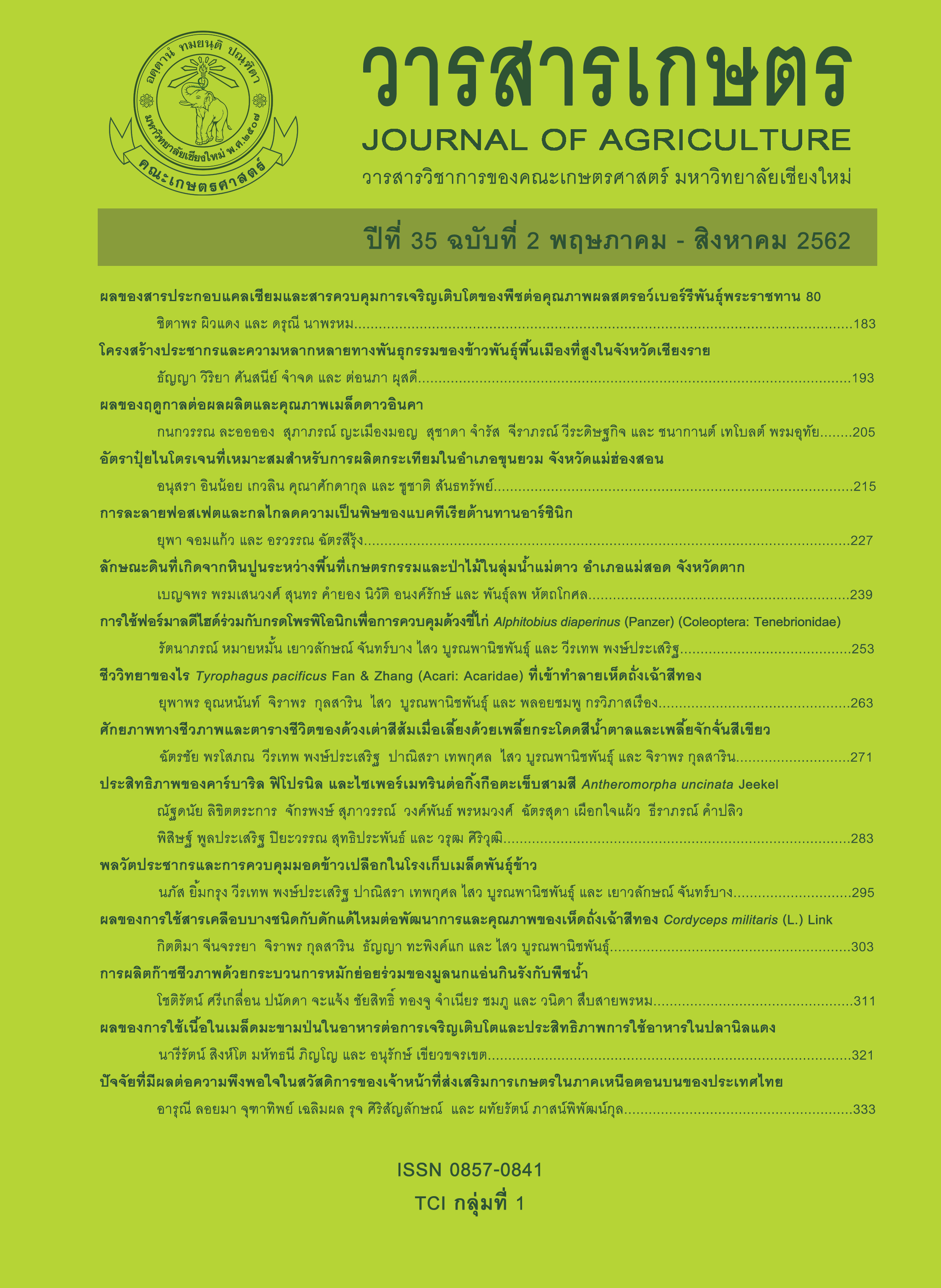Phosphate Solubilization and Detoxification Mechanism of Arsenic-resistant Bacteria
Main Article Content
Abstract
Arsenic (As), known as the 'king of poisons', is the most prevalent heavy metals in most contaminated agricultural-soils of northern Thailand, thus a high risk of food-chain contamination and people health. Many microbes transform arsenic to a less toxic form as a means of resistance. In this study, evaluation of pH alteration and phosphate solubilizing ability under various concentrations of arsenite by five selected isolates i.e. BAs7, BAs8, BAs11, BAs19 and BAs29, was performed. The results indicated that each isolate was able to grow in the medium containing arsenite only when they were able to increase the pH to be more alkali (around ≥ 5.0-6.0) indicating an alkali substance(s) might be released as a detoxification mechanism. Phosphate solubilizing ability of each isolate was increased when exposed to higher arsenite concentration indicating less arsenic uptake thus higher resistance ability. However, the P solubilizing ability was obviously decreased at a critical arsenite levels which were varied from isolate to isolate. In the present study, the critical arsenic levels that markedly decreased the ability to solubilize P of BAs7, BAs 8, BAs11, BAs19 and BAs29 were 50, 100, 50, 100 and 100 mg Na-As(III), respectively. The results highlighted the two detoxification mechanisms; pH alteration towards alkali condition and capability increment of P solubilization, of the arsenic resistant isolates.
Article Details
References
Abou-Shanab, R.A., J.S. Angle, T.A. Delorme, R.L. Chaney, P. Van Berkum, H. Moawad, K. Ghanem and H.A. Ghozlan. 2003. Rhizobacterial effects on nickel extraction from soil and uptake by Alyssum murale. New Phytologist 158(1): 219-224.
Akhtar, M.S., B. Chali and T. Azam. 2013. Bioremediation of arsenic and lead by plants and microbes from contaminated soil. Research in Plant Sciences 1(3): 68-73.
Aposhian, H.V., R.A. Zakharyan, M.D. Avram, M.J. Kopplin and M.L. Wollenberg. 2003. Oxidation and detoxification of trivalent arsenic species. Toxicology and Applied Pharmacology 193(1): 1-8.
Bano, N. and J. Masarrat. 2003. Characterization of a new Pseudomonas aerunginosa strain NJ-15 as a potential biocontrol agent. Current Microbiology 46(5): 324-328.
Chen, W., F. Yang, L. Zhang and J. Wang. 2016. Organic acid secretion and phosphate solubilizing efficiency of Pseudomonas sp. PSB12: Effects of phosphorus forms and carbon sources. Geomicrobiology Journal 33(10): 870-877.
Das, S., J.S. Jean, S. Kar and C.C. Liu. 2013. Changes in bacterial community structure and abundance in agricultural soils under varying levels of arsenic contamination. Geomicrobiology Journal 30(7): 635-644.
Farwell, A.J., S. Vesely, V. Nero, H. Rodriguez, K. McCormack, S. Shah, D.G. Dixon and B.R. Glick. 2007. Tolerance of transgenic canola plants (Brassica napus) amended with plant growth-promoting bacteria to flooding stress at a metal-contaminated field site. Environmental Pollution 147(3): 540-545.
Gaur, A.C. 1990. Phosphate solubilizing microorganisms as biofertilizer. Omega Scientific Publishers, New Delhi.
Khan, A.A., G. Jilani, M.S. Akhtar, S.M.S Naqvi and M. Rasheed. 2009. Phosphorus solubilizing bacteria: occurrence, mechanisms and their role in crop production. Journal of Agriculture and Biological Sciences 1(1): 48-58.
Mandal, B.K. and K.T. Suzuki. 2002. Arsenic around the world: a review. Talanta 58(1): 201-235.
Oremland, R.S. and J.F. Stolz. 2005. Arsenic, microbes and contaminated aquifers. Trends in Microbiology 13(2): 45-49.
Passardi, F., C. Penel and C. Dunand. 2004. Performing the paradoxical: how plant peroxidases modify the cell wall. Trends in Plant Science 9(11): 534-540.
Ratanaprommanee, C., K. Chinachanta and A. Shutsrirung. 2017. Effects of leonadite on soil quality and rice yield improvement. Journal of Agriculture 33(2): 215-224.
Shutsrirung, A. 2003. Characterization of native bradyrhizobia in soybean-growing areas of northern Thailand. Ph.D. Thesis. Mie University, Mie, Japan. 150 p.
Shutsrirung, A. 2012. Selection of microorganism in highland for soil quality improvement in acid and high arsenic soils. Final Report. Highland Research and Development Institute (Public Organization), Chiang Mai. 52 p.
Silver, S. and L.T. Phung, 2005. Genes and enzymes involved in bacterial oxidation and reduction of inorganic arsenic. Applied and Environmental Microbiology 71(2): 599-608.
Smith, S.E. and D.J. Read. 1997. Mycorrhizal Symbiosis. Academic Press, San Diego. 605 p.
Vassilev, A., J.P. Schwitzguébel, T. Thewys, D. van der Lelie and J. Vangronsveld. 2004. The use of plants for remediation of metal contaminated soils. Scientific World Journal 4: 9-34.
Wang, J.P., L. Qi, M.R. Moore and J.C. Ng. 2002a. A review of animal models for the study of arsenic carcinogenesis. Toxicology Letters 133(1): 17-31.
Wang, J., F.J. Zhao, A.A. Meharg, A. Raab, J. Feldmann and S.P. McGrath. 2002b. Mechanisms of arsenic hyperaccumulation in Pteris vittata. Uptake kinetics, interactions with phosphate, and arsenic speciation. Plant Physiology 130(3): 1552-1561.
Zhao, F.J., S.P. McGrath and A.A. Meharg. 2010. Arsenic as a food chain contaminant: mechanisms of plant uptake and metabolism and mitigation strategies. Annual Review of Plant Biology 61: 535–559.


